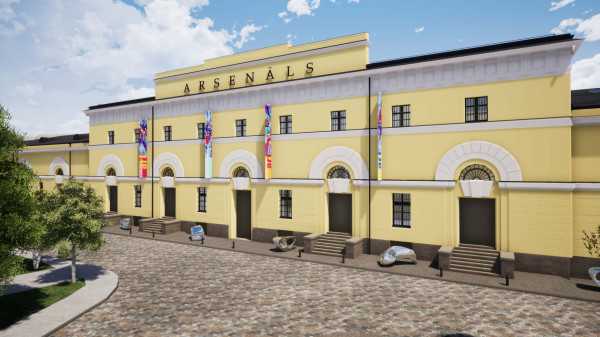








The evaluation of the results of the tender for the construction works at the Arsenāls Exhibition Hall of the Latvian National Museum of Art has been completed and the contract for the design and execution of works is to be concluded with PS “P un S Būvniecība”, informs Jeļena Gavrilova, the Member of the Board of SJSC “State Real Estate” (SRE).
“Arsenāls is not only an important cultural centre, but also a historic building carrying the artistic and architectural heritage of Latvia. The aim of the project is to successfully combine the values of the past with modern technology, modernising the spaces while preserving the authenticity of the building and improving its functionality. The planned renovation also includes the restoration of the unique architectural elements of Arsenāls, for example, the old wooden staircase. In addition, modern energy-efficient ventilation and climate control systems are planned to be installed to ensure the comfort of visitors and staff. Construction works are scheduled to start at the end of this year and the project is expected to be completed in 2028,” informs Jeļena Gavrilova, the Member of the Board of SRE.
For the purpose of improving accessibility, the project also covers the reconstruction of Torņa Street from Jēkaba Street to Arsenāla Street. These works will improve the quality of roads and pavements, making access to the exhibition hall more convenient and safer for all visitors. The redeveloped premises will be adapted to a variety of exhibitions and events, thus ensuring flexible and versatile use. The premises will be improved to comply with building regulations and create optimal conditions for the safe storage and quality display of the artwork.
“The Latvian National Museum of Art is looking forward to further development of this project that is of long-term significance and impact, and goes beyond the limits of a single institution. The aim of the reconstruction and restoration project is to restore and preserve an architectural monument of national significance for the City of Riga and the cultural landscape of Latvia. After reconstruction, Arsenāls has the potential of becoming the largest art exhibition venue in Riga where the museum will implement programmes related to both the study of the recent artistic heritage and the current trends in contemporary art, while also making room for large and prestigious international shows. Respecting the principles of good governance and inclusive society, the new cultural space will serve the community, inviting everyone to discover and experience art, creativity, and openness to diversity. Through the experience of art, we will strive to unite people, communities and their different experiences, emphasising in the development of the project the principles defined by the New European Bauhaus, which relate to aesthetics, sustainability and inclusion, the harmonious use of outdoor space and the implementation of universal design guidelines,” says Māra Lāce, the Director of the Latvian National Museum of Art.
The Arsenāls Exhibition Hall redevelopment and restoration project will be financed by Measure 5.1.1.5 “Restoring Unique European Cultural Heritage to Enhance Accessibility Through the Development of Cultural Services” of the Specific Objective 5.1.1 “Promoting Integrated Social, Economic, and Environmental Development of the Local Territory and Cultural Heritage, Tourism, and Safety in the Functional Areas of Cities” of the European Union Cohesion Policy Programme for 2021–2027.
The Arsenāls Exhibition Hall is an example of architectural classicism and the renovation project is part of the regulatory framework promoted by the Ministry of Culture for the preservation of unique cultural monuments of national significance located in the urban planning monument, i.e. the Historic Centre of the City of Riga, and also within the territory of UNESCO World Culture and Nature Heritage Site – the Historic Centre of Riga. The project provides for the development of five locations in the historic centre of Riga, i.e. the Great Guild, the Arsenāls Exhibition Hall, Vaļņu Street and the surroundings thereof, Daugava Gate, and also to create expositions of the National History Museum of Latvia in Riga Castle.
About Arsenāls Exhibition Hall
The Arsenāls Exhibition Hall of the Latvian National Museum of Art is located inside an important architectural monument, i.e. a customs warehouse building, or arsenal, built in the early 19th century, in the late Russian classicism style, functionally adapted as a museum. The building was originally designed by architect Johann Eduard de Witte. A little later, the design was expanded with suggestions by Julius Adolph Spazier; in 1828, St Petersburg architect Alexander Nellinger and customs department architect Ivan Lucchini prepared the final version, and in November 1832, the official commissioning of the building took place. The Arsenāls building was used as a warehouse throughout its history. It 1920–1930, it accommodated the personal belongings of members of the military. After the Second World War, a department of the Soviet Army used it for storing goods and supplies; it was also used by a military school. In the mid-1980ies, the building was taken over by the Ministry of Culture, which arranged for the creation of a museum there. On 1 January 1989, after the relocation of the second half of the 20th century art collection from a building in Krišjāņa Valdemāra Street, the Arsenāls art museum opened its doors.
About SRE
SRE provides professional real estate management and administration for 419 building and structure properties, comprising 1049 buildings with a total area of 0.98 million square metres, as well as land beneath structures with a total area of 585 hectares, and 3385 land properties with a total area of 937 hectares. SRE is one of 17 Latvian companies that in 2023 received the highest platinum award as part of the Sustainability Index of the Institute of Corporate Responsibility and Sustainability, confirming the good governance and sustainability of its operations. The company was founded in 1996 and the Ministry of Finance is its sole shareholder.

